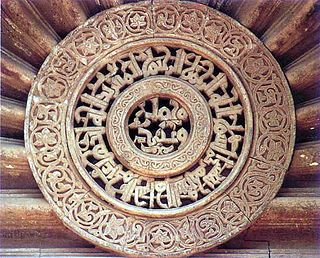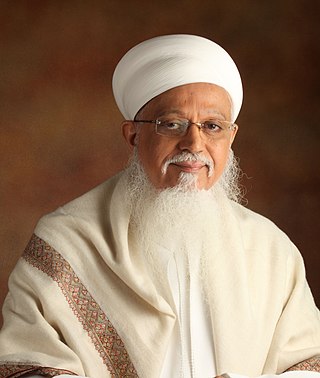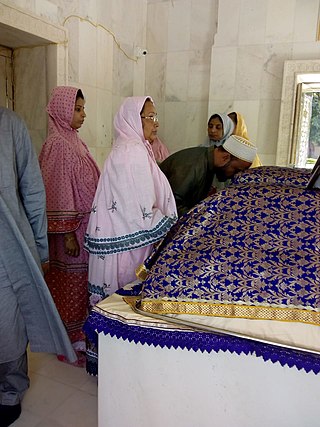
Mohammed Burhanuddin was the 52nd Dā'ī al-Mutlaq of Dawoodi Bohras. He led the community for 49 years in a period of social, economic, and educational prosperity; strengthened and re-institutionalized the fundamental core of the community's faith; revived its culture, tradition, and heritage. In successfully achieving coexistence of traditional Islamic values and modern Western practices within the community, Burhanuddin completed the work his predecessor Taher Saifuddin had started. Burhanuddin was presented the highest national civilian honors of the states of Egypt and Jordan recognising his revivalism and restoration efforts. He was known in Arab countries as Azamat us-Sultan. Owing to extensive travels for community reach-out, he was the first Dā'ī al-Mutlaq to visit Europe, Australia, and America.

Taher Saifuddin, also known as Tahir Sayf al-Din, was the 51st and longest serving Da'i al-Mutlaq of the Dawoodi Bohras. Saifuddin adapted the modernisation in Western and European ideas, and established its benefits for the Bohras, whilst still steeped in the traditions and the culture of the community's Fatimid heritage. Saifuddin laid substantial groundwork in terms of philanthropy, education, entrepreneurship, social outreach, political outreach, and community upliftment upon which his successors continued to build, resulting in an unprecedented era of prosperity among the Dawoodi Bohras.

Da'i al-Mutlaq literally meaning 'the absolute, or unrestricted, missionary', is the most senior spiritual rank and office in Tayyibi Isma'ilism. The Da'i al-Mutlaq has headed the Tayyibi community since the seclusion of the 21st Tayyibi Imam, at-Tayyib Abu'l-Qasim, traditionally placed in 528 AH/1134 AD.

Raudat Tahera is the mausoleum of Syedna Taher Saifuddin and his son and successor Syedna Mohammed Burhanuddin, the 51st and 52nd Dāʿī al-Mutlaqs of the Dawoodi Bohra Ismaili Muslims. It is located in the Bhendi Bazaar, Mumbai.

Syedna Yusuf Najmuddin Bin Syedna Zakiuddin was the 42nd Da'i al-Mutlaq of the Dawoodi Bohra sect of Musta‘lī Islam. He succeeded the 41st Da'i Abduttayyeb Zakiuddin Bin Badruddin, to the religious post.
Syedna Dr. Mufaddal Saifuddin is the spiritual leader, the 53rd Da'i al-Mutlaq of one million Dawoodi Bohras, a subgroup of the Tayyibi, Mustaali, Ismaili Shia branch of Islam. He is the second son of the 52nd Da'i al-Mutlaq, Mohammed Burhanuddin, whom he succeeded in 2014. He is the Chancellor of Aligarh Muslim University and Jamia Miliya Islamia University situated in India. He has led a number of cultural, social, and economic initiatives. In Islamic Cairo, he rebuilt shrines of the Ahl al-Bayt and led the restoration of medieval Fatimid architecture, notably Al-Anwar Mosque, Al-Aqmar Mosque, Al-Juyushi Mosque, and Lulua Mosque. In Yemen, he has spearheaded several campaigns to improve socio-economic conditions of the inhabitants of the Haraaz region, introducing sustainable agricultural systems, improving local infrastructure and providing equal access to education for children.

Syedna Noor Mohammed Nooruddin was the 37th al-Dai al-Mutlaq (vicegerent) of the Dawoodi Bohra Community, a subsect of Shia Islam.

Syedna Ibrahim Wajihuddin Bin Syedi AbdulQadir Hakimuddin was the 39th Dā'ī of the Dawoodi Bohras. He succeeded the 38th Dā'ī Syedna Ismail Badruddin II to the religious post.
The 52nd Da'i al-Mutlaq of the Dawoodi Bohras, Mohammed Burhanuddin died in January 2014. As per the tenets of the sect each predecessor is required to nominate his successor prior to his death. Following Burhanuddin's death, Syedna Mufaddal Saifuddin took up the office of Da'i al-Mutlaq, as per the appointment by Mohammed Burhanuddin. Khuzaima Qutubuddin claiming to have been appointed heir 50 years earlier in secrecy, challenged Mufaddal's right to be Dai in the Bombay High Court.

Mazoon al-Da'wat Shahzada Qaidjoher Ezzuddin is the eldest son of Mohammed Burhanuddin, the grandson of Taher Saifuddin, and elder brother of the incumbent 53rd Dai al-Mutlaq Mufaddal Saifuddin. He is one of the four rectors of Al Jamea tus Saifiyah.

Syedi Fakhruddin Shaheed is the 11th-century holy Ismaili, Fatimid, mustaali saint who was first Ismaili martyr, martyred during missionary work among Bhils local tribal in Rajasthan and buried in Galiakot, India. The mausoleum is the most venerated place amongst his followers.

Abdeali Saifuddin was the 43rd Da'i al-Mutlaq of the Dawoodi Bohra. He was the son of 41st Da'i al-Mutlaq Abduttayyeb Zakiuddin III and the brother of the 42nd Da'i al-Mutlaq Syedna Yusuf Najmuddin. He was a Dai, scholar and poet and one of the most venerated Dawoodi Bohra Dai's.

Syedna Abduttayyeb Zakiuddin Bin Syedna Ismail Badruddin was the 41st Da'i al-Mutlaq of the Dawoodi Bohra sect of Ismaili Musta‘lī Islam. He succeeded the 40th Da'i Hebatullah-il-Moayed Fiddeen, to the religious post.
Syedi Khanji Pheer was an Indian Ismaili Dawoodi Bohra saint. He lived in the 17th century. His family settled in Udaipur, coming from Gujarat during Udaipur's establishment. He was titled Saheb-e-Hiqmatul-Marefat. He was the teacher of seven Dawoodi Bohra Da'is.

Syedna Tayyeb Zainuddin Bin Syedi Jivanjee was the 45th Da'i al-Mutlaq of the Dawoodi Bohra sect. He succeeded his brother, the 44th Da'i, Syedna Mohammed Ezzuddin Bin Syedi Jivanjee, to the religious post at the age of 38 years.

Syedna Mohammed Ezzuddin Bin Syedi Jivanjee was the 44th Da'i al-Mutlaq of the Dawoodi Bohra sect. He succeeded the 43rd Da'i, Syedna Abde'Ali Saifuddin, to the religious post at the age of 29. He was born in 1788.

Aljamea-tus-Saifiyah is an Arabic academy dedicated to Islamic learning based in India, Pakistan, and Kenya. Established in Surat as Dars-e Saifeec. 1810 by Abde'Ali Saifuddin, it was after extensive renovation and expansion carried out by Taher Saifuddin and Mohammed Burhanuddin, the university gained prominence. Today, as holder of the office of Dāʿī al-Mutlaq, Mufaddal Saifuddin is the sole benefactor of the institute.

Syedi Lukman ji bin Syedi Dawood Bhai was an Ismaili Dawoodi Bohra saint who lived in the 17-18th century in India. His family settled in Udaipur, coming from Gujarat during Udaipur's establishment. He was associate (Mawazeen) of 40th Dai Syedna Hebatullah-il-Moayed Fiddeen. He has served three Dai from Syedna Ismail Badruddin II to Syedna Moayed. Syedi Lukman ji saheb died on the 29th of Rajab 1177AH/1764AD. His shrine (dargah) is in Udaipur, in the locality of Bohra wadi.

Bawa Mulla Khan was a Dawoodi Bohra saint who lived in the 18th century in India. He died on the 29th of Shawwal. His shrine (dargah) is in Rampura, Madhya Pradesh, India.
Burhanpur Dargah case was filed to resolve the dispute arisen due to right to the use of certain waqf property belonging to Dawoodi Bohra, situated in Burhanpur, India.



















